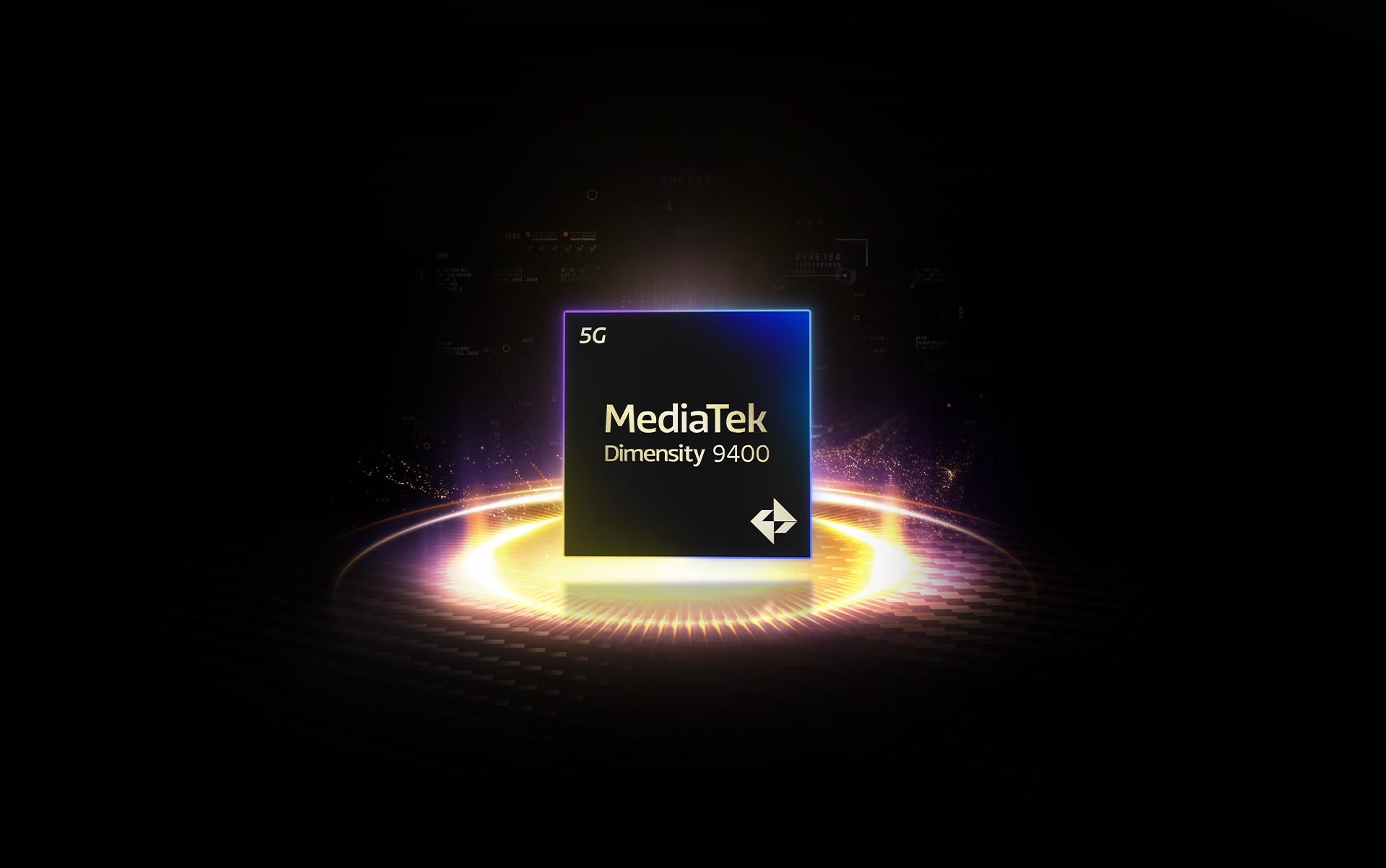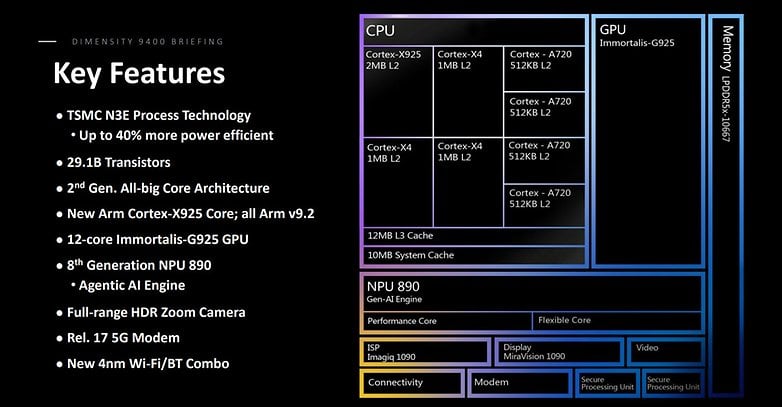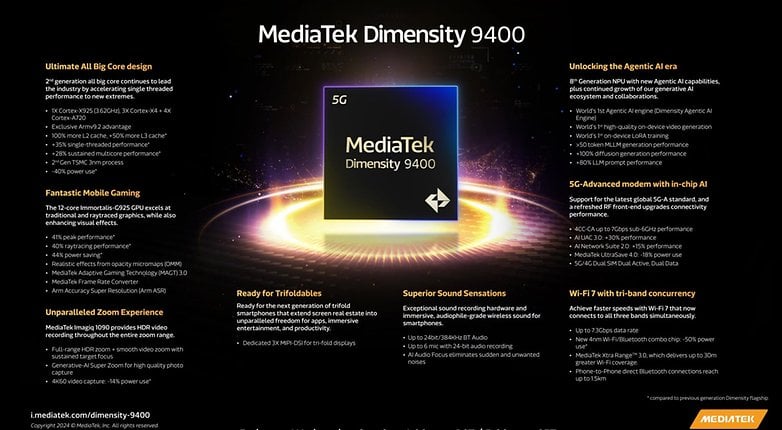
MediaTek played the underdog role for many years but its recent launches showed increasingly competitive offerings on the mobile SoC space. Its latest processor for Android phones, the Dimensity 9400, brings the best CPU and GPU cores from ARM to fight for the top spot in the performance (and efficiency) charts. Let’s take a look.
The MediaTek Dimensity 9400 follows the unusual layout adopted by its predecessor without the efficiency (small) Cortex-A5x cores in use for more than 10 years already. For the 2025 season, the Dimensity 9400 brings one Cortex-X925 big CPU (launched earlier this year by ARM), with three Cortex-X4 CPUs from 2023 (from the same generation as the big cores on the Dimensity 9300), and four Cortex-A720.
| MediaTek Dimensity 9400 | Qualcomm Snapdragon 8 Gen 3 | Samsung Exynos 2400 | Google Tensor G4 | Apple A18 Pro | MediaTek Dimensity 9300 | Qualcomm Snapdragon 8 Gen 2 | Google Tensor G3 | Apple A17 Pro | |
|---|---|---|---|---|---|---|---|---|---|
| Prime core |
|
|
|
||||||
| Performance core |
|
|
|
|
|||||
| Efficiency core |
|
|
|
|
|||||
| RAM |
|
|
|
|
|
|
|
|
|
| GPU |
|
|
|
||||||
| 5G modem |
|
|
|
|
|
||||
| Connectivity |
|
|
|||||||
| Process node |
On the graphics side, the Dimensity 9400 packs 12 cores of the ARM Immortalis-G925 GPU, keeping support for raytracing rendering, and introducing ARM’s take on rendering super-scaling: ARM Accuracy Super Resolution—AASR, to join the tsunami of rival acronyms: DLSS, FSR, XeSS, GSR, PSSR, and the non acronym MetalFX.
MediaTek calls its implementation HyperEngine Super Resolution (HESR, anyone?) but the basics are the same for all of them: Render a gaming scene at a lower resolution internally to expand it to a higher one on-screen, saving on power and performance at the cost of some artifacts. For AASR, ARM based its technique on AMD’s FSR2 temporal upscaler, which interpolates pixels based on data gathered from past frames.

The new chip uses TSMC’s second-generation 3-nm-class process node, known as N3E. MediaTek is the second company to publicly announce a consumer-market chip on that node, a few weeks after Apple’s A18 chips launched with the iPhone 16 line.
Apple is clearly TSMC’s preferential partner, but MediaTek is also making the most of its close relationship with the Taiwanese foundry. Eric Fisher, MediaTek’s Corporate Vice President, highlighted this during a press event, noting that the company is also working with other manufacturers like UMC, Global Foundries, and Intel Foundry.
Compared to the previous generation chip—made on TSMC’s N4P process—, MediaTek advertises a 28% sustained CPU performance improvement (35% on single-threaded tasks), or a 40% decrease in power consumption. Similarly, the GPU side promises 41% peak performance or 44% power savings.
| MediaTek Dimensity 9400 (MediaTek’s estimates) |
Dimensity 9300 (Xiaomi 14T Pro review) |
Snapdragon 8 Gen 3 (RedMagic 9s review) |
Google Tensor G4 (Pixel 9 Pro review) |
Apple A18 (iPhone 16 review) |
|
|---|---|---|---|---|---|
| AnTuTu | |||||
| Geekbench |
|
|
|
|
Take those numbers with some skepticism until third-party reviews go live, but at least they seem plausible. For the AnTuTu fans (which Chinese phone brands are the biggest ones, apparently), MediaTek even gave a 3,000,000 score for the Dimensity 9400 under a “laboratory environment” (AKA no thermal constraints).
Speaking of constraints, not to be limited by 2024’s generative AI trend, MediaTek is touting “agentic AI” as the next “turning point” and was quick to remind us that the Dimensity 9400 is compatible with it. In short, agentic AI can be considered a feature that doesn’t require prompts to act, using your data and circumstances to autonomously make decisions and take actions. However, just as we are now seeing practical uses of gen-AI, don’t expect to see agentic AI anytime soon.
Truth be told, long before ChatGPT and Stable Diffusion, mobile chip companies were already including AI processing on their chips, but for its 8th-generation AI core, MediaTek is adopting the NPU name instead of the previously used (and confusing) term “APU”.
Back to practical improvements, MediaTek touts an improved Imagiq 1090 image processor (ISP) with improved zoom both in digital magnification and HDR support, with a lower power usage while recording video. The Dimensity 9400 video processing block now supports 8K60 encoding with HEVC at 8-bit depth, and video decoding offers the same codec support as the 9300 predecessor: AVC (h.264), HEVC (h.265), VP9, and AV1.

The Dimensity 9400 is compatible with the latest Bluetooth 5.4 and Wi-Fi 7 standards, just like its predecessor. MediaTek, however, noted that the combo chip uses a more efficient process node, promising 50% lower power consumption, improved range, and even a 25% efficiency improvement in demanding Wi-Fi hotspot use.
The Dimensity modem now supports the 3GPP Rel-17 standard on the cellular side. While downlink speeds remain capped at 7 Gbps using only sub-6GHz bands, as with the previous generation, MediaTek promises improved network utilization and reduced power consumption in real-world scenarios.
Availability
According to MediaTek, the first smartphones powered by the Dimensity 9400 will be available “starting in Q4 2024”. So be ready for upcoming announcements from the usual brands such as Oppo, Vivo, and Xiaomi.
With MediaTek’s leading market share in the Android market and the significant design win on the Galaxy Tab S10 series, the company is forecasting a 50% growth in the flagship SoC market for 2024 in comparison to 2023.
The pressure is now on Qualcomm’s side on how it will deal with the Taiwanese challenge on the flagship market. With the Snapdragon summit scheduled for later this month, it won’t be long before we have that answer.






